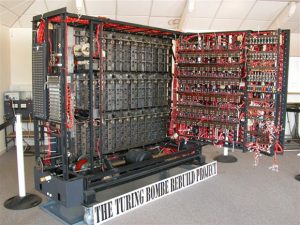How Plants Are Named
Part 2

Alan Turing’s Computer, which was named “the Bombe”
In the 20th century, plant names began changing very rapidly due to the convergence of three extraordinary advances in science. These revolutionary findings have far reaching implications in taxonomy, now and even more so in the future. Their impact cannot be underestimated in myriad disciplines beyond taxonomy.
In a 1936 paper, Alan Turing described what he called an “automatic machine” that could solve any computing problem described as a sequence of mathematical steps. He also showed that one machine could stimulate another machine and that a machine could hold both data and code. In 1938 Turing worked with the British government where he famously cracked the codes used by the Germans in World War II by deciphering their “Enigma” machine. Thus began the computer age.

Watson and Crick
In 1983, Kary B. Mullis formulated a revolutionary way to make copies of DNA molecules. The polymerase chain reaction (PCR) enabled the replication of portions of DNA in large quantities in a laboratory.

Kary Mullis
Testing methods to sequence DNA began as slow, painstaking, manual techniques. The same was true for PCR tests. Now, PCR and DNA sequencing are automated tests with results often available in hours once the purified nuclear material is produced. These tests have moved far beyond the university and research settings from which they began.
Computer advances are simply astonishing. Our cell phones have more computing power than the computers used to send Apollo 11 to the moon. Artificial intelligence is a reality.

Structure of DNA
The genetic material of plasmids is often analyzed. At their most basic level, plasmids are small circular pieces of DNA that replicate independently from the host’s chromosomal DNA. Scientists worldwide are rapidly building large databases of plant DNA, both from plasmids and from the cell nucleus.
The nomenclature and classification of plants will continue to confound gardeners and scientists for years to come. The potential changes brought about by our new knowledge are just beginning. For scientists, this is an adventure at least on par with the profound change in understanding living things following the acceptance of the theory of evolution.
References
• Molecular Structure of Nucleic Acids, a Structure for Deoxyribose Nucleic Acid, James D. Watson,
Francis H.C. Crick, Nature, April 1953
• The Francis Crick Papers, U.S. National Library of Medicine Profiles in Science
• Turing’s Enduring Importance, Simson Garfinkel, Massachusetts Institute of Technology (MIT) Technology
Review, 2012
• The Discovery of PCR, Deana Namuth-Covert, University of Nebraska Lincoln
• Chemical Components of PCR, Deana Namuth-Covert, University of Nebraska Lincoln